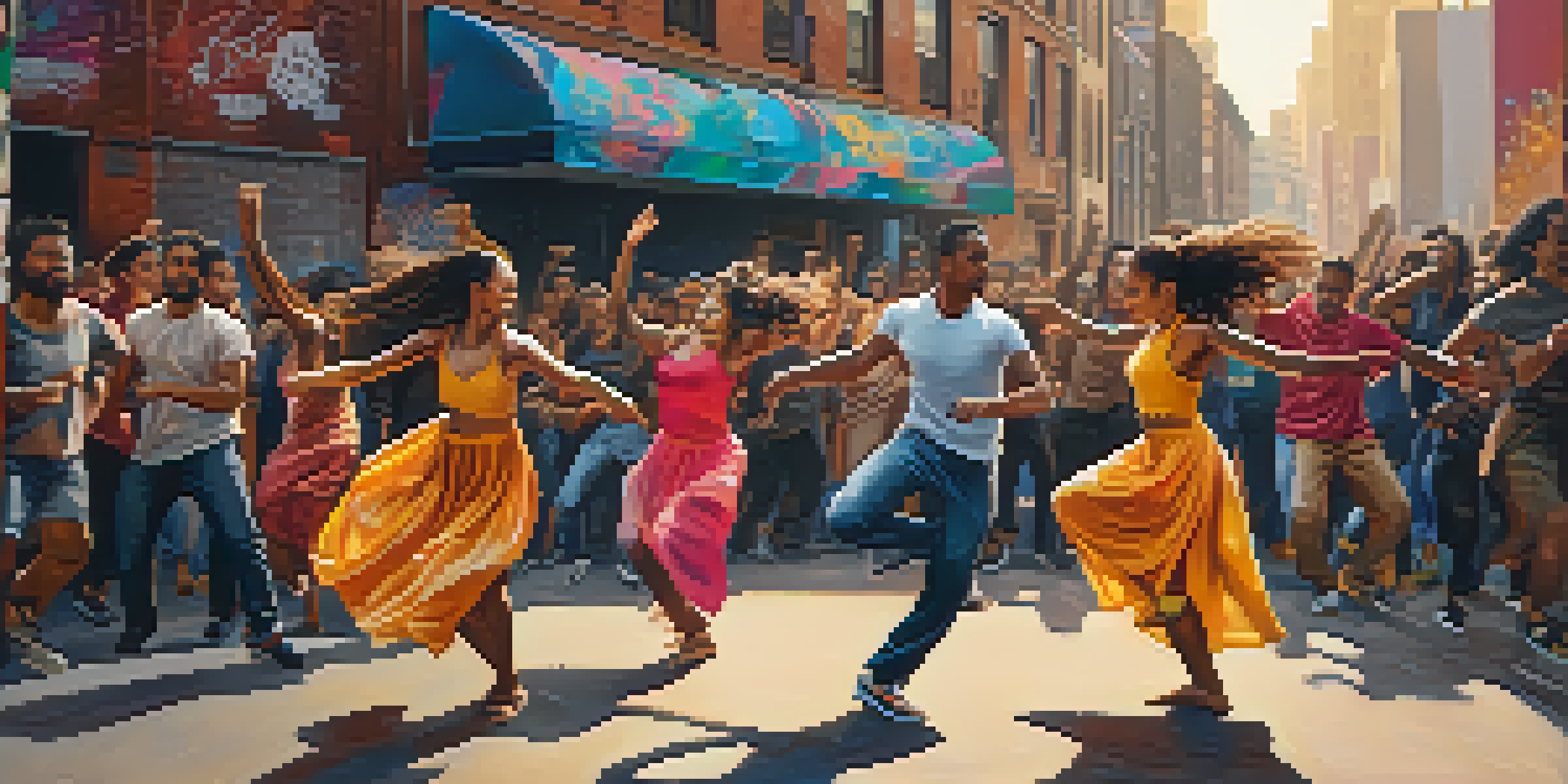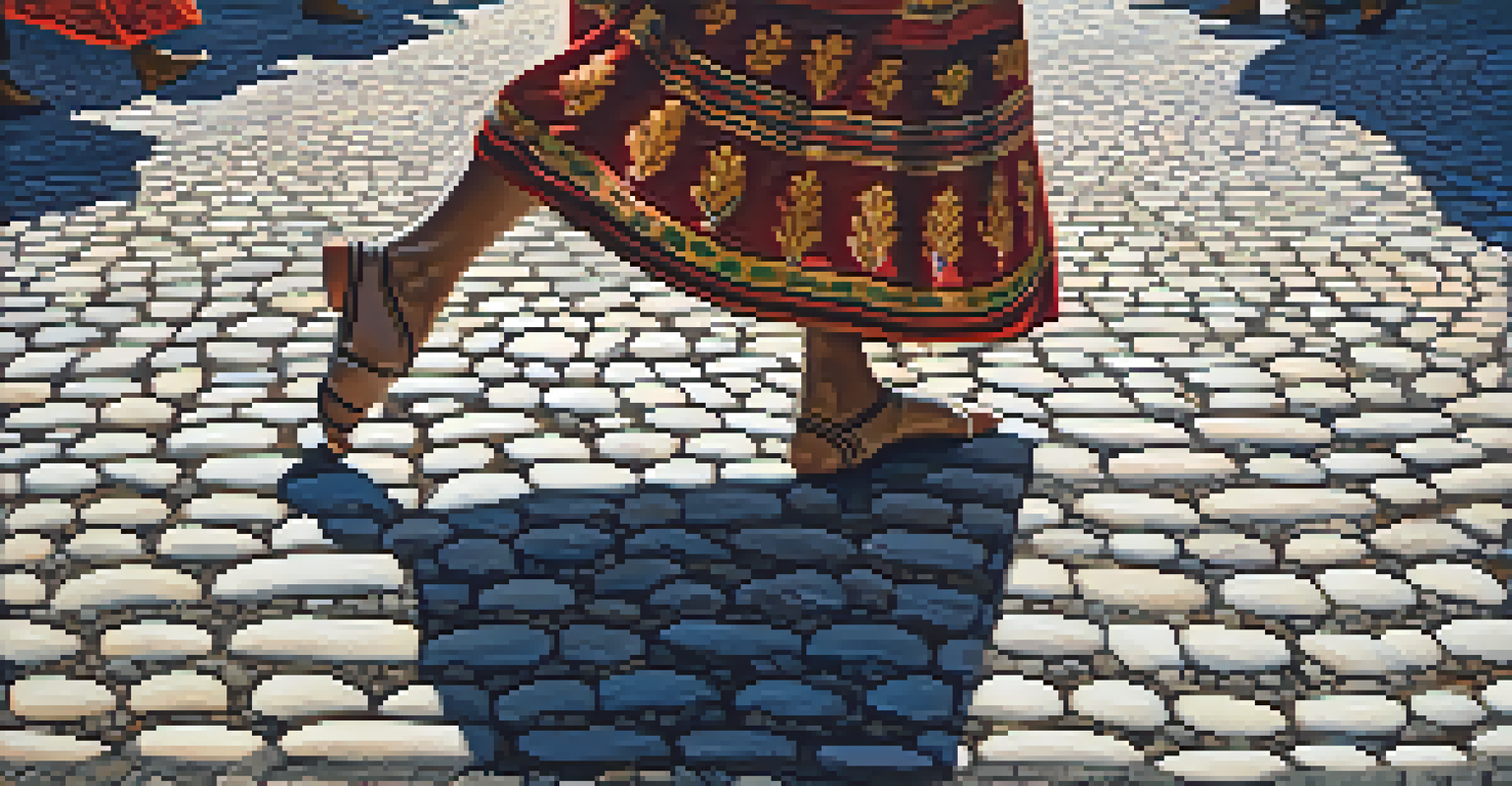Movement and Meaning: Dance in Times of Social Unrest

The Historical Role of Dance in Social Movements
Throughout history, dance has been a vital form of expression during social movements. From civil rights marches to protests, dance often embodies the emotions and struggles of the people. For instance, the iconic 'Black Power' salute during the 1968 Olympics showcased how movement can convey a powerful political message.
Dance is the hidden language of the soul.
This tradition continues today, as dancers use their art to reflect societal issues and inspire change. In many cultures, dance serves as a communal activity that unites people around a shared cause. By moving together, participants can feel a sense of solidarity that transcends words.
Moreover, dance has the unique ability to reach audiences on an emotional level, often igniting a passion for social justice. Just as a powerful speech can move listeners, a compelling dance performance can stir hearts and provoke thought, making it a potent tool for activism.
Dance as a Form of Protest
In times of social unrest, dance emerges as a compelling form of protest. It is a way for individuals to express dissent and challenge the status quo without uttering a single word. Take, for example, the 'Dance of the Dead' performed during protests against police brutality, which captures grief and anger in a visceral way.

This non-verbal communication can resonate deeply within communities, creating a shared language of resistance. When people dance together in protest, they not only express their frustrations but also affirm their collective identity. It becomes a declaration of existence in the face of oppression.
Dance as a Voice for Change
Throughout history, dance has been a powerful tool for social movements, allowing individuals to express emotions and inspire collective action.
Dance also invites spectators to engage with the message on a personal level, bridging the gap between artist and audience. This engagement can foster empathy and understanding, making the issues at hand more relatable and urgent for those who may be unaware or indifferent.
The Emotional Power of Dance in Turbulent Times
Emotion is at the heart of dance, especially in times of social unrest. Movements can evoke feelings of joy, sorrow, anger, and hope, allowing individuals to process their experiences collectively. For example, during the Black Lives Matter protests, dance became a channel for expressing pain and resilience.
The dance is a poem of which each movement is a word.
Choreographers often draw from real-life events to create pieces that resonate with current social issues. These performances can serve as cathartic experiences, both for the dancers and the audience. By witnessing the raw emotions expressed through movement, viewers may find themselves reflecting on their own feelings and experiences.
Moreover, dance can act as a balm for communities in turmoil, providing a sense of solace and connection. When people come together to dance in solidarity, they not only share their grief but also cultivate hope for a better future, reinforcing the idea that change is possible.
Global Perspectives: Dance Around the World
Dance as a medium for protest is not confined to any one culture; it is a global phenomenon. In countries like Brazil, the samba has long been associated with political resistance, while in South Africa, traditional dances have played a role in anti-apartheid movements. Each culture brings its unique flavors and traditions to the dance floor, enriching the collective narrative.
For instance, in the Middle East, dancers have used traditional folk dances to assert their identity amid political turmoil. These performances can become acts of defiance, reclaiming space and culture in times when they are threatened. The fusion of local styles with contemporary dance creates a powerful commentary on resilience and hope.
Global Unity Through Dance
Dance serves as a universal language that transcends cultural boundaries, uniting people in their struggles for justice across the globe.
As we explore these global perspectives, it's clear that dance transcends borders, uniting people in their struggles for justice. This interconnectedness reminds us that while experiences may differ, the human spirit's desire for freedom resonates universally, making dance a truly global language.
The Intersection of Dance and Digital Media
In today's digital age, social media has transformed how dance is used as a form of protest. Platforms like TikTok and Instagram allow dancers to share their messages with a global audience instantly. Viral dance challenges often emerge in response to social issues, making activism accessible and engaging.
These online performances can spark important conversations and inspire action, as viewers are drawn to the creativity and passion displayed. For example, the viral 'Savage' dance challenge was used to raise awareness about racial injustice, blending entertainment with activism seamlessly.
Digital media also allows marginalized voices to be heard, amplifying their stories and experiences through dance. By creating and sharing content online, dancers can connect with others who share their values, fostering a sense of community that extends far beyond physical boundaries.
Choreography as a Reflection of Society
Choreography often serves as a mirror reflecting societal issues and emotions. Dancers and choreographers use their art to comment on current events, weaving narratives that challenge viewers to think critically about the world around them. For example, works inspired by the #MeToo movement have opened up discussions about consent and power dynamics.
The creative process can also be deeply political, as choreographers choose movement vocabulary that reflects their perspectives on social issues. This intentionality can transform a seemingly simple dance into a profound statement about injustice and resilience.
Digital Media Amplifies Dance Activism
In the digital age, social media has transformed dance into a widespread form of protest, enabling activists to share their messages with a global audience instantly.
By engaging with these choreographed pieces, audiences are encouraged to reflect on their own beliefs and actions. This interaction between art and activism invites a deeper understanding of societal challenges and inspires individuals to advocate for change.
The Future of Dance in Social Movements
As we look to the future, the role of dance in social movements will likely continue to evolve. With the increasing intersection of technology and art, new forms of expression will emerge, shaping how messages are conveyed. Virtual performances and interactive experiences could become common, allowing for even broader participation in activism.
Moreover, as global issues like climate change and inequality gain attention, dance will remain a vital tool for raising awareness and fostering community. Dancers will continue to use their platforms to advocate for change, connecting with audiences in innovative ways.

Ultimately, the future of dance in social movements is bright, as it remains an essential form of expression that transcends language and culture. With each step, twirl, and leap, dancers convey the hopes and struggles of their communities, inspiring others to join the movement for a better world.